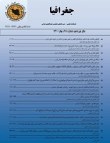Morphometric Parameters of Glacial Cirques in the Heights of Central Kerman Province
Cirques have long been used as a direct indicator of the extent and nature of old glaciers, so they are an indicator of past climates. The heights of Kerman province with high altitude and snow cover as a cold-humidity center in Central Iran, has glacial landforms such as cirques, valleys and glacial sediments. Among these landforms, cirques play a very important role in supplying water to large parts of the region by storing snow and ice. Morphometric and geoalometric analysis of glacial cirques in the region can reveal environmental changes and climate fluctuations during the Late Quaternary period.
A total of 884 glacial cirques were identified in the area and plotted on a graded map in two linear and polygonal formats. By fitting the power models to the longitudinal profile of the cirque works, the coefficients and statistical parameters of the circuses in the region were extracted. cirque classification operations were based on the methods of Wilburg and Rudberg, Evans and Cox. For the morphometry of these cirques, parameters such as (L), (W), (H), (L / W), (L / H), (W / H) and the size of the cirque are used and its morphometric characteristics.
To accurately identify the location of glacial cirques, the study area is divided into 81 sub-glacial basins. Of these, 19 sub-basins are located in Jupar heights, 12 sub-basins in Khyber heights, 16 sub-basins in Jabal Barez heights, 15 sub-basins in Plovar heights and 19 sub-basins in Bidkhan, Hezar and Lalehzar heights. At altitudes above 3,000 meters below the glacial basins, 884 glacial cirques in the area were identified, classified, and drawn on a map in two linear and polygonal formats. There are 133 glaciers in Bidkhan heights, 231 in Lalehzar heights, 262 in Hezar heights, 91 in Jopar heights, 66 in Pluvar heights, 85 in Jabal Barez heights, and 16 glaciers in Khyber heights. In the developed cirques, the studied area has a greater ratio of length to width of these cirques, and according to the longitudinal axis, these circuses are stretched in the direction of the valley and have a longitudinal shape. At the heights of Bidkhan, Hezar, Jupar and Jabal Barez, the coefficient of change of the transverse axis of the evolved cirques is higher than the coefficient of change of their longitudinal axis. Accumulation of ice and snow in cirques of this category and the lack of movement of ice and snow due to its small volume and melting, as well as the activity of running water causes the destruction of cirque walls and increase the coefficient of change in the transverse axis of cirques of this category In the heights of Bidkhan, a thousand mountains have become visible. In Jupar heights, most of the roughnesses are composed of Kerman conglomerate formation, along with the lower limestones. Glacial erosion combined with erosion due to melting and freezing of ice has caused erosion of the side walls of the circuses and as a result has increased the coefficient of variation along the transverse axis of the circuses of Jopar Heights. The average coefficient b for the longitudinal axis of cirques N2, N1 N3, Bidkhan heights, Lalehzar, Hezar, Jupar and Jabal Barez is less than 1. In general, the coefficient b for the longitudinal axis of the cirques of these heights is equal to B <1. As a result, allometric behavior is negative for cirques at these altitudes. Low coefficients b for cirques in this category indicate the low impact of glacial erosion on the evolution of these cirques. The average coefficient b for cirques N1, N2, N3 of Plovar heights is equal to 1.0171. In these cirques it is 1
At the heights of Bidkhan, Hezar, Jupar and Jabal Barez, the coefficient of change of the transverse axis of the evolved cirques is higher than the coefficient of change of their longitudinal axis. Pluvar Heights has the largest cirques in the region with its cirques of 1194.5 meters. After that, the heights of Barez Jabal with cirques of 1176.7 meters are in the next rank in terms of the size of cirques in the region. In the study area, Jupar Heights with circuses of 994.9 meters has the smallest developed cirques in the region. The average coefficient b for the longitudinal axis of the cirques of category N2, N1 N3 of Bidkhan, Lalehzar, Hezar, Jupar and Jabal Barez heights is less than 1. In general, the coefficient b for the longitudinal axis of the cirques of these heights is equal to B <1. As a result, allometric behavior is negative for cirques at these altitudes. The average coefficient b for cirques N1, N2, N3 of Plovar heights is equal to 1.0171. In these cirques it is 1 <B. In these cirques, the allometric situation is somewhat established. The average coefficient a for the transverse axis of cirques N1, N2, N3 of Lalehzar heights is equal to 0.72, in heights of one thousand equal to 0.96, in heights.
- حق عضویت دریافتی صرف حمایت از نشریات عضو و نگهداری، تکمیل و توسعه مگیران میشود.
- پرداخت حق اشتراک و دانلود مقالات اجازه بازنشر آن در سایر رسانههای چاپی و دیجیتال را به کاربر نمیدهد.



